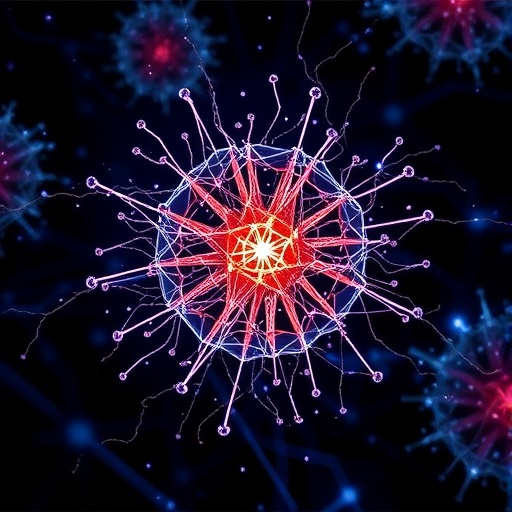Physicists from the University of Copenhagen have leveraged the colossal magnetic fields that permeate galaxy clusters to investigate distant supermassive black holes, unveiling a fascinating clue in the decades-long pursuit of axions—hypothetical particles that may unlock one of the most profound mysteries in cosmology: dark matter. This breakthrough represents a pioneering approach, transforming the cosmos itself into an immense natural laboratory to detect elusive signals previously thought beyond our observational grasp.
At the heart of this research lies an extraordinary interplay between some of the universe’s largest and smallest components. Galaxy clusters, gravitationally bound congregations of hundreds or thousands of galaxies, are among the most massive structures known, tipping scales quadrillions of times heavier than our Sun. Meanwhile, axions—conceived in particle physics as nearly massless, yet fundamentally significant—have remained stubbornly undetectable within terrestrial laboratories, despite their theoretical appeal, particularly in solving the strong CP problem and accounting for the elusive dark matter that is estimated to make up approximately 80 percent of the total cosmic mass.
Traditionally, efforts to uncover axions have entailed intricate and precise experiments using particle accelerators and highly sensitive detectors here on Earth. However, the innovative strategy adopted by the Copenhagen team circumvents these constraints by turning telescopes toward the universe’s distant powerhouses: active galactic nuclei powered by supermassive black holes. These regions emit prodigious amounts of high-energy electromagnetic radiation, notably gamma rays, that traverse the vast cosmic web, including the intricate magnetic environments of galaxy clusters en route to Earth.
The crux of the method hinges on the theoretical property that gamma rays passing through magnetic fields could occasionally convert into axions—a transformation predicted by particle physics beyond the standard model. However, the highly complex and turbulent magnetic fields in galaxy clusters inject a considerable degree of randomness and unpredictability into this conversion process. A single observational dataset would be inundated with noise, rendering the axion signal virtually indistinguishable from statistical fluctuations.
To overcome this formidable difficulty, researchers implemented a novel approach akin to cosmic signal stacking. By meticulously observing and aggregating data from 32 separate distant active galactic nuclei situated behind galaxy clusters, they synthesized an ensemble dataset wherein the random fluctuations from individual sources effectively averaged out. This process revealed a distinct step-like pattern in the radiation spectrum, a feature consistent with the theoretical footprint of axion-related gamma ray conversion.
Oleg Ruchayskiy, Associate Professor at the University of Copenhagen’s Niels Bohr Institute and lead author of the study published in Nature Astronomy, described the results as a “cosmic whisper”—a faint, yet tantalizing signature that emerges only when multiple noisy signals are combined across many observations. He emphasizes that such a step-like spectral pattern acts as a unique fingerprint for axion-like particles, not previously visible in isolated measurements, signifying a leap in observational astrophysics and particle physics synergy.
This discovery not only edges us closer to empirical glimpses of axions but also provides valuable constraints on their possible properties. By effectively ruling out certain parameter spaces where axions cannot exist, the work narrows the theoretical hunting grounds. Lidiia Zadorozhna, a Marie Curie fellow and co-author, highlights that this methodology extends beyond gamma rays; it holds promise for other electromagnetic bands such as X-rays, broadening the scope of future searches.
The magnetic fields of galaxy clusters are monumental both in scale and complexity, stretching over millions of light-years with strengths ranging between a few microgauss to tens of microgauss. These fields influence the propagation of high-energy photons profoundly, enabling the conversion phenomena that underpin this study. Yet, their intricate spatial variations and turbulence have long challenged theoretical predictions, explaining why individual observations yielded ambiguous results and why combining data was necessary to extract clearer signals.
Moreover, this technique’s adaptability allows subsequent investigations to probe extensive mass and energy ranges for axions and axion-like particles, which may constitute a major component of dark matter. As theoretical models posit, axions interact extremely weakly with ordinary matter but could reveal themselves indirectly through their electromagnetic interaction mediated by magnetic fields, as elegantly demonstrated by these astrophysical observations.
The implications of this approach are profound, suggesting that our universe’s colossal structures not only serve as cosmic beacons but also as particle physics laboratories inaccessible to any manmade instrument. As the data improves with next-generation gamma ray observatories and more detailed mapping of galaxy cluster magnetic fields, the sensitivity and certainty of such searches are expected to grow, potentially culminating in a direct detection of axions.
While the findings are not yet conclusive proof of axions’ existence, they mark a pivotal step toward unraveling the nature of dark matter. By progressively excluding forbidden regions in axion parameter spaces and revealing indirect observational signatures, physicists can refine both astrophysical models and particle theories to closer align with reality.
In the grand cosmic tapestry, where the very largest gravitational giants host the faintest quantum whisper, this research exemplifies the exciting frontier where astrophysics meets particle physics. The pursuit for axions embodies humanity’s enduring quest to understand the unseen majority of the cosmos—dark matter—and the innovative use of galaxy clusters’ magnetic fields may soon herald a new era of discovery.
For more detailed insights, the original work is documented in the article “Constraints on axion-like particles from active galactic nuclei seen through galaxy clusters” published in Nature Astronomy (August 15, 2025). This research opens a promising research avenue that can be replicated and expanded using different radiation types and larger datasets, continuing to peel back layers of the cosmic mystery enveloping dark matter.
Subject of Research: Axion-like particles, dark matter, active galactic nuclei, galaxy clusters, magnetic fields, gamma ray astronomy
Article Title: Constraints on axion-like particles from active galactic nuclei seen through galaxy clusters
News Publication Date: 15-Aug-2025
Web References: https://www.nature.com/articles/s41550-025-02621-8, DOI: 10.1038/s41550-025-02621-8
Image Credits: Illustration by Lidiia Zadorozhna, Niels Bohr Institute, University of Copenhagen
Keywords
axions, dark matter, galaxy clusters, gamma rays, magnetic fields, supermassive black holes, active galactic nuclei, particle physics, cosmology, electromagnetic radiation, astro-particle physics, Nature Astronomy




